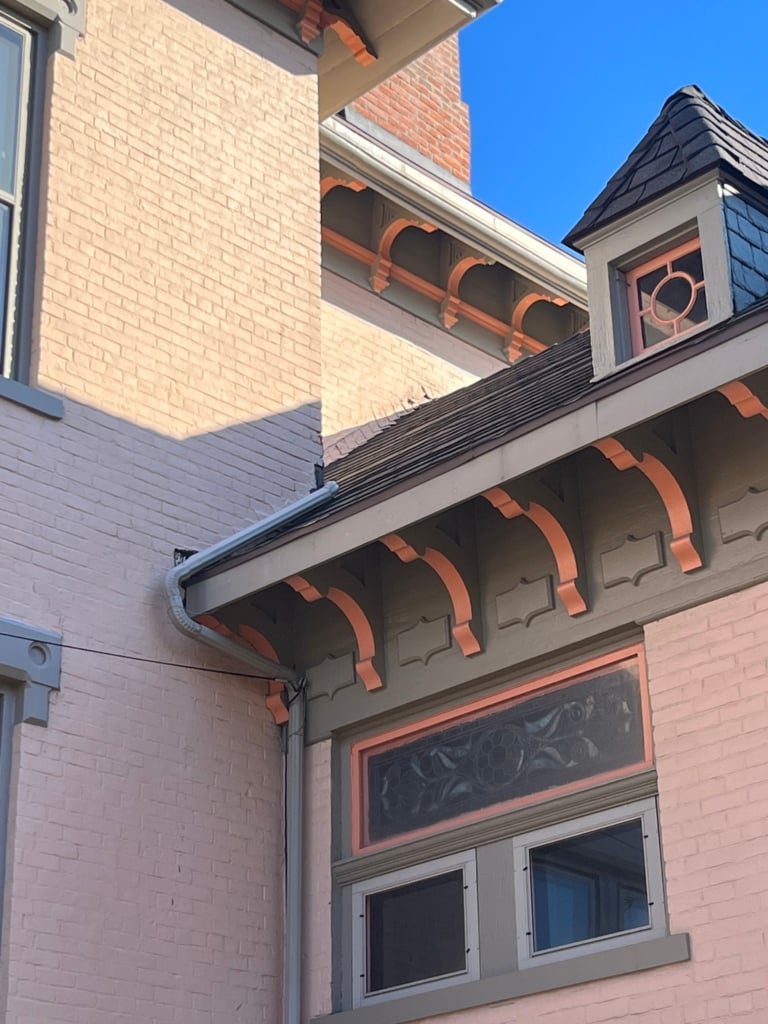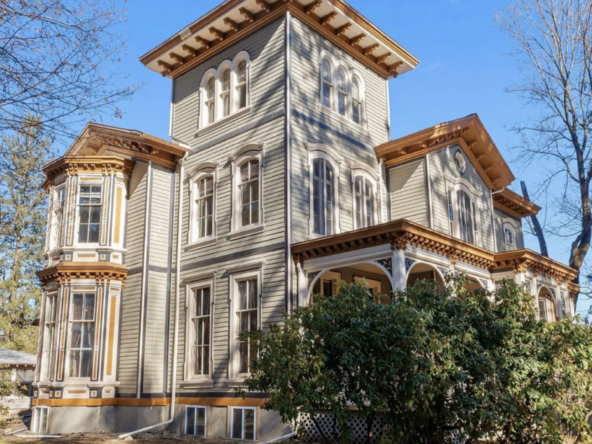Walk around any historic neighborhood and look up. Just under the rooflines, delicate scrolls, sturdy supports, bits of carved or jigsaw-cut wood that seem to float beneath the eaves. These are brackets. And while they may be small, they are anything but insignificant.
Like so many details in old houses, brackets—and their siblings corbels, consoles and modillions—do the quiet work of holding everything together. Sometimes literally, often symbolically. They’re a blend of beauty and utility, structure and soul. Once you start noticing them, you can’t stop.
If the old house photos featured here look familiar, it’s no coincidence! These details can be found on the same c. 1873 Italianate home in Hudson, NY, recently offered for sale on CIRCA Old Houses; now in the hands of a family eager to help bring it back to its full glory—brackets and all!
What Exactly Is a Bracket?

A bracket is a projection—something that juts out from a wall to support what’s above. Think roof eaves and porch overhangs on the exterior, arches and shelving on the interior. In historic homes, brackets are rarely just structural. They’re usually decorative too, often with incredible detail produced either by the hand of a skilled artisan or, especially after the mid-19th century, machines in a factory.
Andrew Jackson Downing, our American patron saint of picturesque domestic architecture, didn’t use the word “bracket” all that often, but he understood their purpose. In The Architecture of Country Houses (1850), he writes:
“The projecting rafters or brackets under the eaves in the Swiss and Italian villas give great spirit and character to the outline of the roof…”
In Downing’s world, the bracket wasn’t just a support—it was a statement. About good taste. About a house’s relationship to its setting. About beauty with a purpose.
So Then, What’s a Corbel?

Think medieval castles, Roman arches, or Gothic cathedrals. A corbel is typically stone or masonry, often built into the wall itself to bear real weight. You’ll see them holding up arches, projecting balconies, or just adding mass and muscle to a building’s silhouette.
In historic residential architecture, especially once we hit the Victorian era (roughly 1837 to 1901, the period of Queen Victoria’s reign in England), the line between brackets and corbels starts to blur. They can look very similar, but I tend to refer to interior supports made of plaster or wood as “corbels”. But then, especially if it sports a scrolling S-surve, I might call it a “console”—a familiar feature of Classical and Beaux-Arts architecture and decorative arts.
While we’re on the subjects of terminology, history and style, let’s not leave out “modillions,”those flattened, leaf-like attachments under a Classical entablature. From the front, they can look like teeth, hence the term “dentil” or “denticulated” cornice. These are the visual vestiges of primitive architecture—stylized echoes of exposed beam ends in early timber construction.
Late 19th- and early 20th-century styles (for example, Queen Anne and Arts & Crafts) circled back to the literal structural significance of these architectural elements in the form of exposed rafter tails.
Edith Wharton Knew
By the time Edith Wharton wrote her 1929 novel Hudson River Bracketed, the term “bracketed” would have already been widely understood by readers as shorthand for a certain kind of old-fashioned, elaborately detailed house typical of the mid-1800s. Her young writer protagonist stumbles upon a decaying house and is struck by its dramatic, bracketed charm:
“It was bracketed, cupola’d, bay-windowed, mansard-roofed, and porticoed, with all the architectural fixin’s that the mid-century taste regarded as indispensable.”
Wharton isn’t just describing a building—she’s showing us what it meant. The layers of aspiration, taste, and ambition encoded in every jigsaw curve.
Brackets and Corbels Are the Heartbeats of a House
When you walk into an old house and feel that something—the sense that this place has a soul—it’s not just the marble fireplace or the grand staircase. It’s the small things.
So yes, brackets, corbels, consoles and modillions matter. They may be small, but they carry the weight of history, beauty, and memory. They are, in every sense, worth preserving.
If you’d like to jump on board for my Italianate preservation adventures in Hudson, please sign up for my biweekly newsletter and follow me on Instagram .
 AUTHOR KATE WOOD grew up criss-crossing the country in the family’s Volkswagen Bus, visiting house museums, battlefields, Main Streets, and national parks. Today, she is an award-winning preservationist, real estate broker and principal of the full-service historic rehabilitation consulting firm, Worth Preserving. Kate believes in the essential value of old-building stewardship to sustain community character. For her, each property is a cause and each client a fellow advocate. She specializes in matching people with properties, skilled contractors, historic tax credits and other benefits to support top-tier rehabilitation projects.
AUTHOR KATE WOOD grew up criss-crossing the country in the family’s Volkswagen Bus, visiting house museums, battlefields, Main Streets, and national parks. Today, she is an award-winning preservationist, real estate broker and principal of the full-service historic rehabilitation consulting firm, Worth Preserving. Kate believes in the essential value of old-building stewardship to sustain community character. For her, each property is a cause and each client a fellow advocate. She specializes in matching people with properties, skilled contractors, historic tax credits and other benefits to support top-tier rehabilitation projects.





